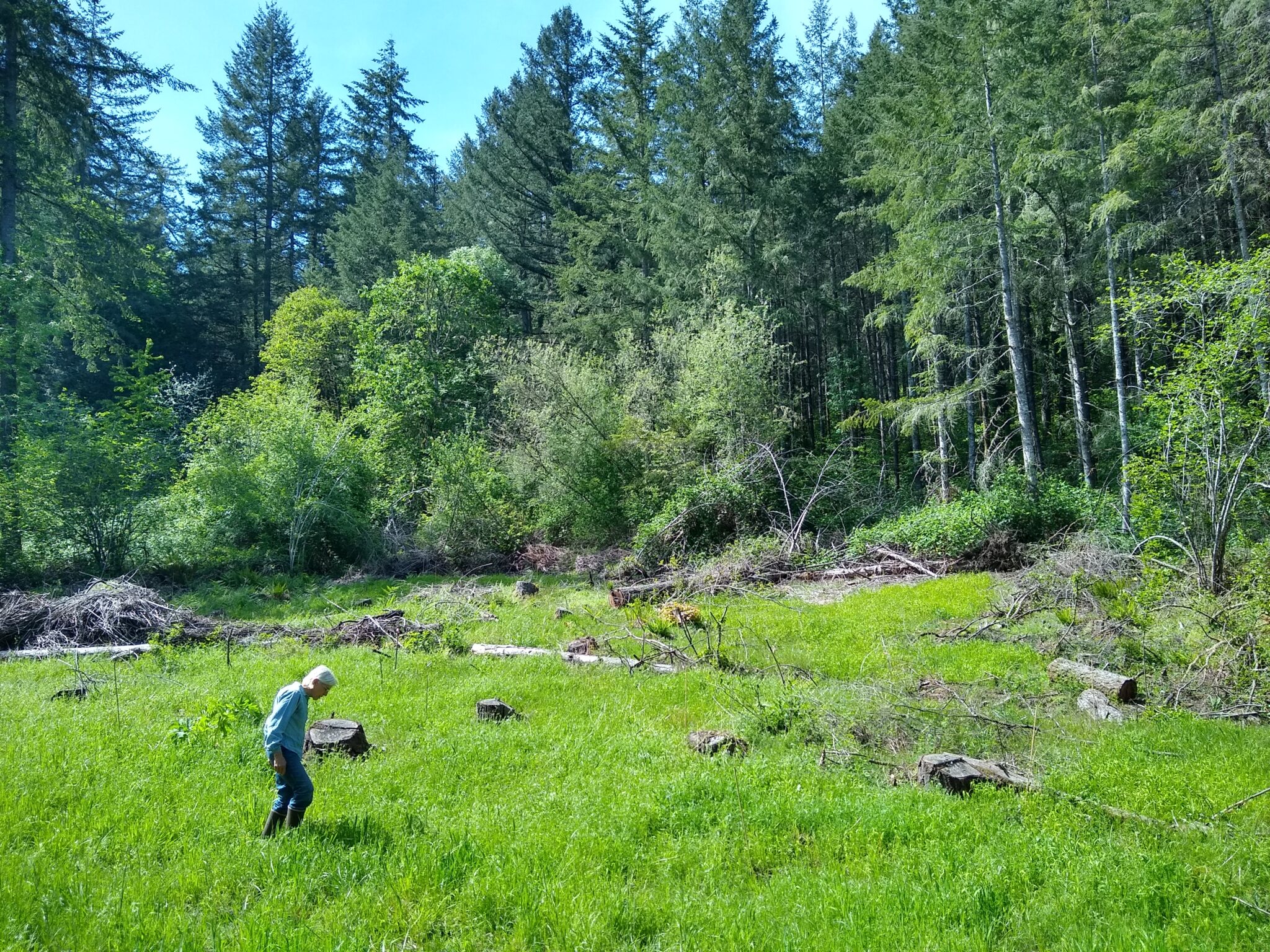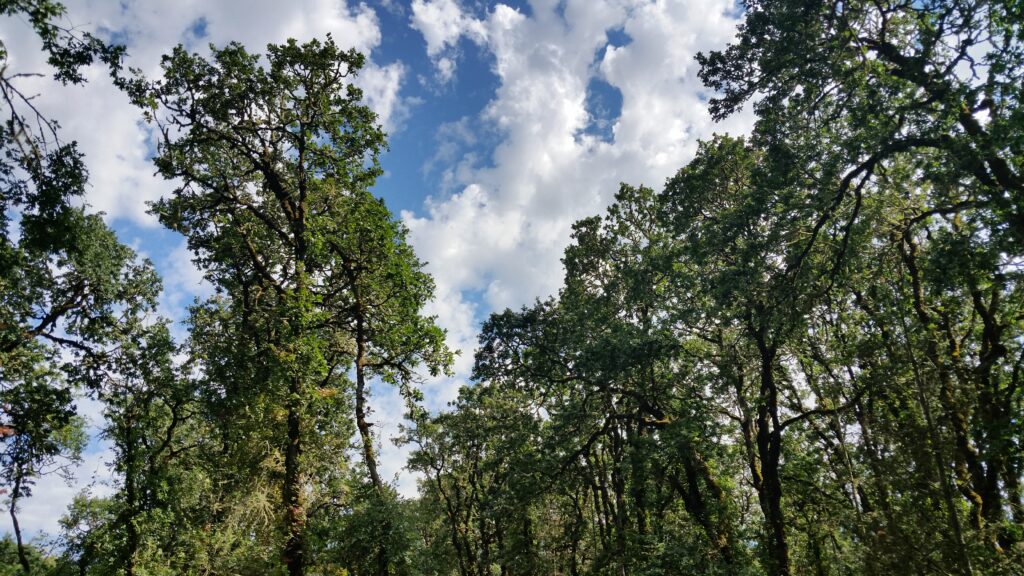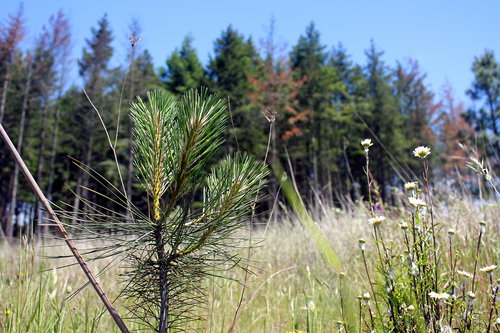Forest Adaptation: Half Art, Half Science

Sarah Deumling and her family steward Zena Forest, a member of NNRG’s group FSC® certificate. Their stewardship goals—to create an ecologically sustainable uneven aged and mixed species forest including all tree, plant and animal species native to the area—are supported by their business, Zena Forest Products, which sell beautiful hardwood flooring, lumber and millwork from timber harvested and milled on-site.
The largest contiguous block of forest in the Willamette Valley, Zena Forest has not been immune to the impacts of climate change. Summers are hotter and drier, and between 2012 and 2020 the Deumlings lost 10% of their Douglas-fir. These changes are consistent with model predictions of the way Oregon climate is shifting under the influence of global warming.

For twenty years, the Deumlings have been experimenting with planting less-traditional tree species—ones more tolerant to a warming climate—including Incense cedar, Coast redwood, Giant sequoia, Oregon white oak, and Ponderosa pine. They’ve also been sourcing Douglas-fir seedlings from farther south, where they may already be adapted to a warmer and drier climate.
Last week we caught up with Sarah Deumling to hear how Zena’s woods are faring, and how their young seedlings are surviving the summers.
Have you continued to see large-scale Douglas-fir die-offs?
The die-offs of fir have continued. It varies from year to year, though. Last year we had a long wet spring, which gave the planted seedlings a better chance to survive that summer. There was less mortality overall. But this year’s very dry spring led to large numbers of dead and dying fir again. It’s continuing to happen in predictable areas: sites exposed to the southwest, areas with poorer soil, or areas with high drainage. We tend to see the most mortality mostly in seedlings and younger trees (30-40 years old), and less mortality in more mature trees (50-60 years old and older). The Doug-fir stands that are doing the best tend to be in higher elevation sites.
Overall, though, I’m done with planting Douglas-fir. Last summer most of them made it, but this summer wiped out any scraggly ones. Even the ones sourced from farther south have had a really hard time during the summers.
What about the seedlings you’ve been planting of “non-traditional” species?
Those experiments have been – for the most part – successful. We’re thinking seriously about what to plant, where. The Incense cedar and the native Oregon white oaks have been winners for survival. The oaks have these deep taproots that can access water more easily than the fir, which have very flat roots. And they have chemical mechanisms for dealing with drought.*
We’re very happy about how the Coast redwoods are doing, though many of the 10-20 year old redwoods crashed in a huge ice storm in 2021. I’ve since replanted 100 acres with a mixture of redwood, sequoia, and incense cedar, and the redwoods that crashed are re-sprouting at the stumps.**
We have a few stands that are mixed Douglas-fir and Giant sequoia, including some 60 year old sequoia. They’re less tapered than the sequoias grown in yards, and they’re very robust.
We continue to plant Ponderosa pine, but not too much of it. It’s certainly a good substitute for fir in the sites where we’ve removed fir. We took out dying fir on these large areas, initially planted oak, then planted pine in areas where oak didn’t make it. But we’re not quite sure how the pine will do over time. They seem to be suffering a little in the hot summers, some get a lot more brown needles than they should be getting, and a few are dying. The jury is out on that one.
This isn’t something we’ve planted ourselves, but we have madrone scattered here and there and it’s doing terrifically. I think they’re right up there with oak for being the best species for survival going forward. But, we are just relying on natural regeneration with the madrones. I have tried pulling them up and transplanting, but it doesn’t work. So whenever it comes up by itself I cut the fir away from it to give it space and sunlight – if it gets sunshine it grows straight. And they’re good about sprouting back after elk browse. They’re definitely a minor species but we’re giving them due space.

Any final thoughts on planting a forest for the future?
I’m not a data-driven scientist, and I think forestry is half art, half science. We’ve been doing this for years, and we’re still learning. We really don’t know what’s going to grow in the long term. Our first hope is to have a forest on this property for the grandchildren. If you’re looking to harvest, planting oak and madrone or incense cedar isn’t a very smart idea. But if we’re looking for a forest, we have no choice but to look for the species that have the greatest chance of surviving the rapidly changing climate.
*Note: Historically, oak and maple were more dominant in the Willamette Valley. Frequent low-intensity fires, often purposefully set by indigenous peoples, favored open landscapes dotted with hardwoods like oak and maple. The burn suppression that the Northwest has experienced in the last 150 years has selected for conifers instead.
**Coast redwood is unique among conifer species due to its propensity to reproduce through sprouts after harvest or disturbance.
